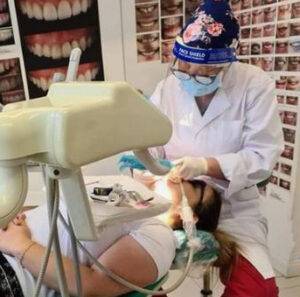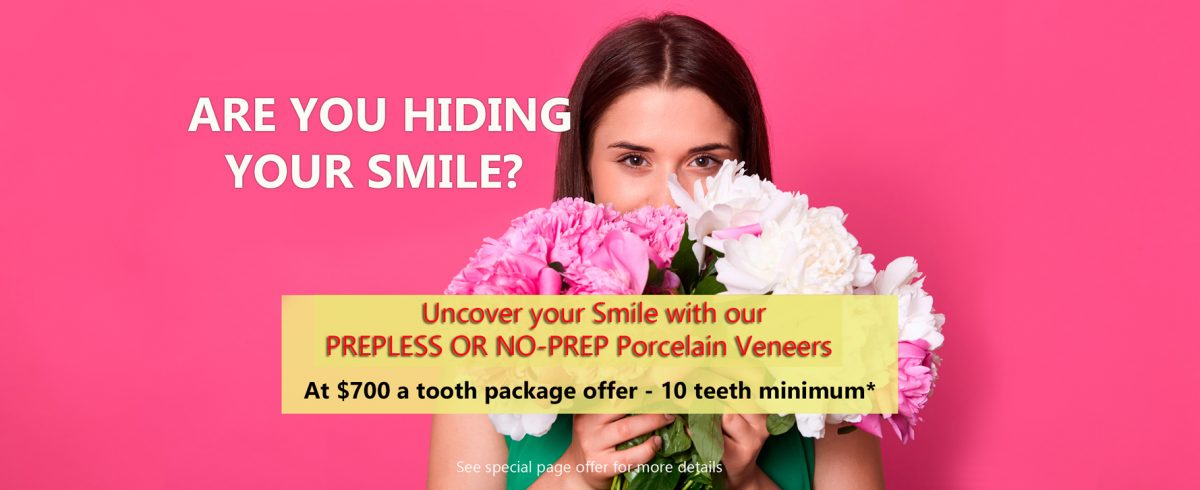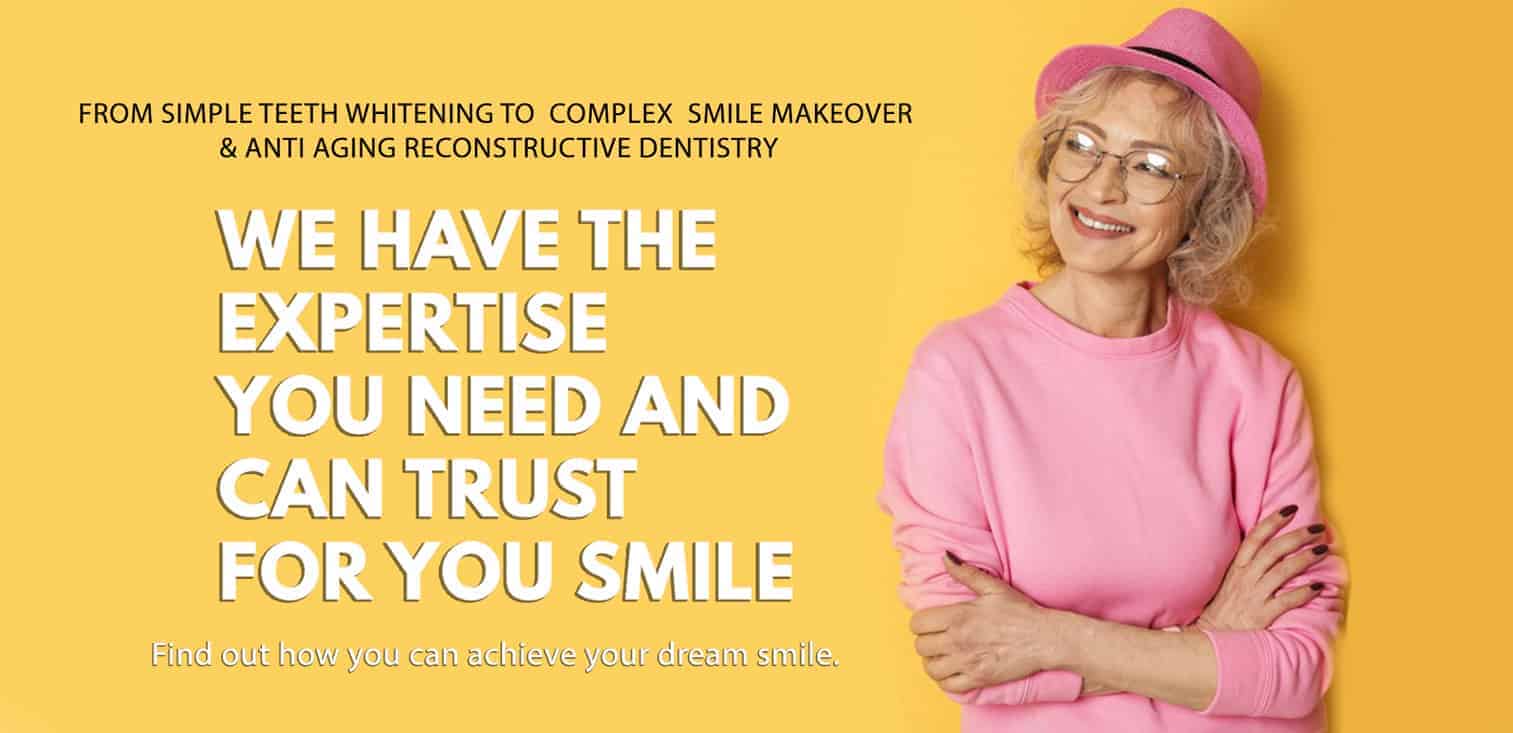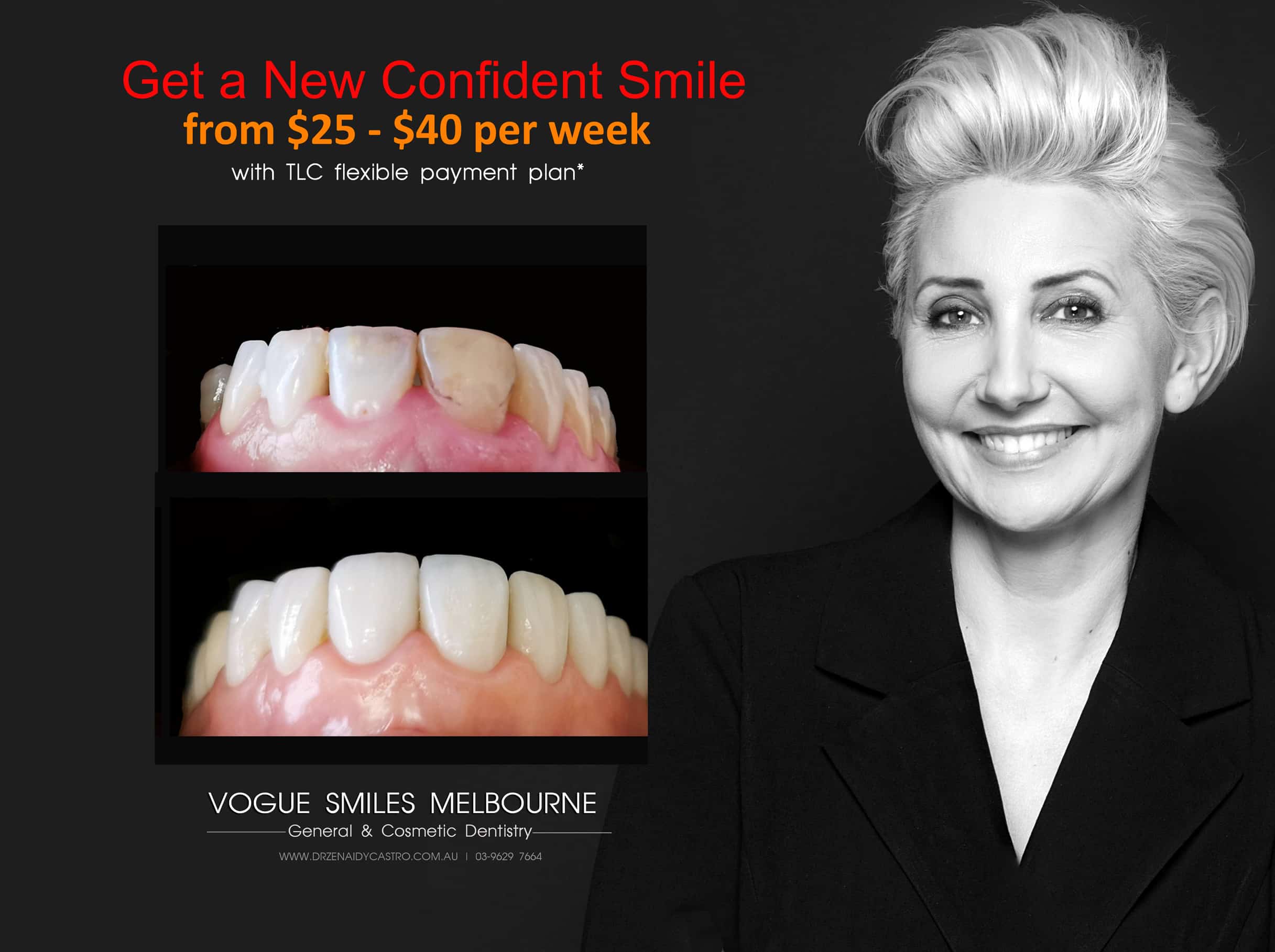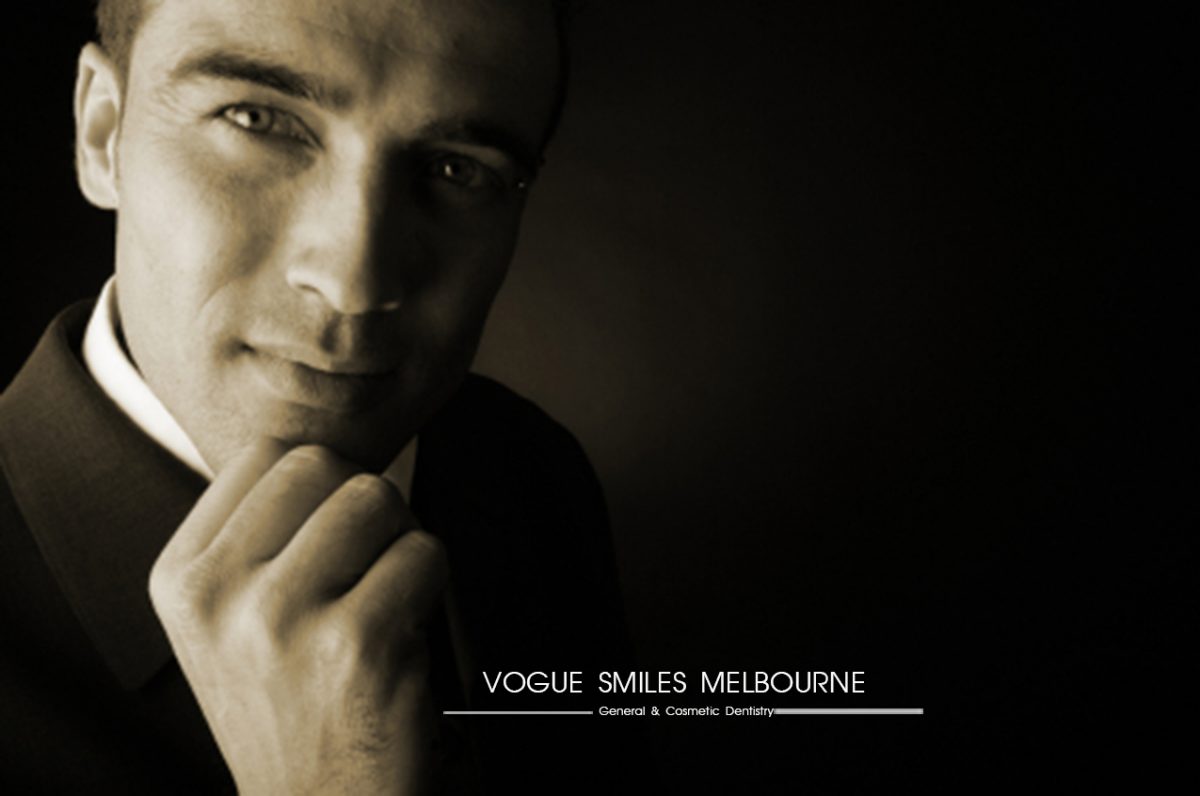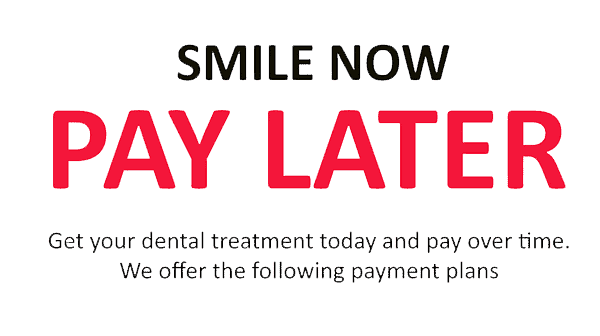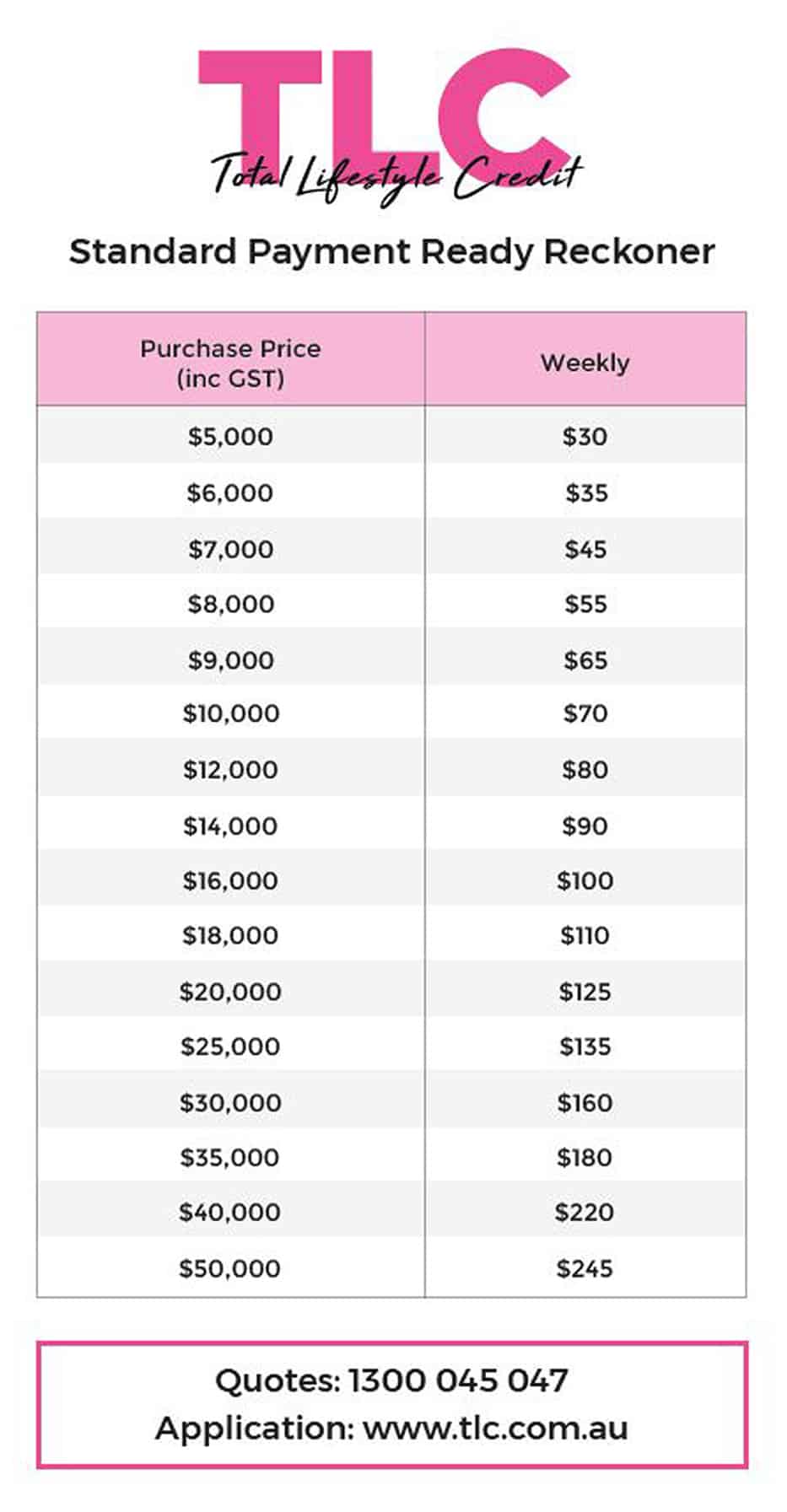To Our Cosmetic Patient about to receive their New Smiles
Again, thank you for giving us the opportunity in assisting to your smile transformation journey.
And Congratulations! You are about to receive your new smile. How exciting would that be! You’ve made a life-altering decision to improve your smile. Cosmetic Dentistry treatment is unquestionably worthwhile for all the benefits it gives and undoubtedly worth the price for many people. A beautiful smile can boost self-esteem and help people feel confident about their appearance, making the treatment invaluable.
Cosmetic dentistry is a significant investment, and I want you to maximise the benefits of your investment in your new smile for many, many years. To accomplish this, I urge you to now invest in your time reading and becoming acquainted with how you should care for them. The email and document that we sent you, along with the links provided below, will provide you with complete information and knowledge on what to expect and how to care and safeguard for your new restorations.
What to expect during your Cementation booking
If you haven’t seen your new porcelain restorations yet, I’ll show them to you before I finish your cementation work. On that appointment, I will discuss and answer any questions/clarifications you may have about our postoperative care of your new porcelain restorations, including our three-year limited warranty. I’ve revised our postoperative care and three-year limited warranty.
After removal of your temporaries, if you have, I will do a trial fitting first and give you the opportunity to preview and assess it before cementation. To ensure that you are happy with everything, you must preview and assess every aspect of your new restorations, such as the look, shade, dimensions, and everything related to aesthetics. If you are happy with everything and approve for cementation to go ahead, I will then request your approval and consent to finish and cement your restorations. I will have you then sign a hard copy consent form.
Take note that once the restorations have been cemented, they will be difficult to change without additional time, money, and biological cost to the teeth of having these removed. If further intervention is performed, the teeth may lose vitality. So, you must be certain of your decision and consent for me to cement your porcelain restorations, as changing your mind later and replacing them can only be done at your own expense, as well as the biological cost on the teeth that may be incurred during the restoration removal process.
The only alterations that I can do on cemented restorations includes the following below:
-Adjusting your high bite if needed,
-Minimally adjusting the length of the porcelain if needed,
-Minor reshaping the corners of the biting edge of your porcelain
-Adjusting the back of your porcelain should you not get used to or have difficulty pronouncing some letters such as F or V.
– To a certain degree, I can remove minor aspects of your porcelain as mentioned above, but I cannot change the colour of your existing veneers, add anything to your porcelain, do a major overhaul, or completely remove them.
That is why you will need to see me again after your cementation for a 5-10 minute post-cementation appointment. This adjustment, if necessary, is made at that last post-cementation appointment. If you believe you require more than checking and minor adjustment, please let me know so I can schedule a longer appointment time for you.
Adjustment period after Cementation
Each patient will have a unique adjustment period timeline. Some patients report zero side effects following their cosmetic procedure. Others require days or even weeks to fully adjust.
Right after placement, your mouth can feel strange as you slowly become used to the dimensions and new look and changes of your newly enhanced teeth.
Whenever you receive new dental restorative or cosmetic work that slightly alters the shape, size, or placement of your teeth or gums, your mouth is extremely sensitive to the change.
You may find your tongue running over your new restorations constantly, as it discovers the shape of your new smile.
For most patients, the adjustment period for porcelain veneers lasts about two weeks. There will be gradual improvements in these issues each day during this brief adjustment process.
After two weeks have passed, most patients should feel just fine with their porcelain restorations in place. They will hardly notice that they have undergone cosmetic dental work.
RECOVERY AFTER VENEER, CROWN AND BRIDGES CEMENTATION PROCEDURE
After you receive the treatment, patients can return to work that same day, and also resume normal activities that day, too.
If you receive sedation dentistry with the procedure, however, you will need the rest of the day to recuperate. Furthermore, someone will need to drive you home after the appointment since you will be unable to drive for the remainder of the day. The next day, though, you can definitely return to normal activities.
It is normal for patients to experience some sensitivity, discomfort or pain initially, which should subside after the first few days.
Numbness from Anaesthetic
If a local anaesthetic was used during the dental procedure, the numbing effect may still be present for several hours after the dental appointment.
During this time, patients are prone to burn or bite themselves unknowingly because they are unable to feel the warning sensations, such as heat or pain, as usual. For this reason, it is recommended to avoid drinking hot liquids or chewing hard foods during this time.
There may also be some bruising and inflammation at the site of the anaesthetic injection shortly after the dental crown procedure, particularly on the lower jaw. This should go away spontaneously without the need for treatment after several days.
Pain, Discomfort and Sensitivity
Most patients experience some pain or discomfort in the affected area of the mouth following a dental procedure. This typically improves after several hours, days or weeks without any assigned treatment.
Many patients find it useful to use simple analgesic medications to help manage the pain in the meantime.
Tooth sensitivity is a common recovery symptom. To deal with this discomfort, consider using a toothpaste designed for sensitive teeth. Avoiding consuming very hot or cold foods and beverages can also help. Try using a straw if you’re still experiencing sensitivity.
Gums Recovery from Gum lifting procedure
Any reshaping to improve the profile of the gum tissue by raising or lowering it, is included within the scope of most cosmetic or restorative works. Most gum contouring procedures require anywhere from few days to a week to fully heal.
The extensiveness of the work largely determines the healing window. If a lot of gum tissue is removed, healing is likely to take few days to a week or two. If only a small amount of tissue is removed, healing is likely to take only a few days instead.
As the anaesthesia from the procedure wears off, patients may encounter varying levels of pain.
For mild or lift sculpting treatments, there is likely to be little pain at all.
Over-the-counter pain treatments should be sufficient after the treatment. Using an ice pack on the affected area for 15 minutes at a time for the first couple of days post-procedure can help reduce pain and swelling.
Pain should fade within the first few days even for more advanced lifts. If pain and swelling are bothersome after a particularly advanced gum graft or lift, the dentist can always prescribe you some anti-inflammatory medication to help.
The First Few Days after Cementation
More often than not, your new porcelain restorations may feel slightly larger than the natural teeth they cover. This feature allows your new porcelain attachments to reshape your teeth in an aesthetically pleasing manner. Shortly after your veneers are placed, you may notice that your tongue and inner cheeks can feel the features of your porcelain shells. These will be momentary distractions that will fade over the following days.
Some patients report heightened sensitivity to heat and cold. This sensitivity may be most noticeable when eating ice cream, for example. A small number of patients report that their speech is slightly impeded due to the porcelain restorations. This is no different than what our patients report after having braces or another attachment or prosthetic placed. Any chance to the surface of the teeth can require that your palate readjusts.
While you are on the adjustment period, go easy when your eat. Try not to eat something hard or chewy while you are getting use to your new bite and new restorations.
What If I Still Have Veneer Adjustment issues?
If you still have issues with your porcelain veneers more than two weeks after getting them, it’s a good idea to discuss these matters with us.
How to Make Porcelain Veneers Last
Porcelain veneers can last up to 15 to 20 years if properly cared for. They have the potential to last a lifetime if properly cared and maintained for. To get the most out of your restoration, you should adhere and implement some basic oral care guidelines and routine as recommended on this link here and some from this email.
To implement this new daily oral hygiene routine, you need to have first the knowledge on the how-to’s ( which is provided on this email and links), and second the strong desire and motivation to implement this as new routine. As you strictly implement this routine, things will become a new habit. On average, it takes more than 2 months before a new behaviour or habit becomes automatic — 66 days to be exact according to study. And how long it takes a new habit to form can vary widely depending on the behaviour, the person, and the circumstances.
Bear in mind, developing this good new oral hygiene habit on your daily oral hygiene routine will not only be good for your new restorations but as well to the rest of your teeth.
Below you will find some few pointers on looking after your veneer and porcelain restorations.
Tips for Caring of Your Porcelain Restorations (Veneers, Crowns & Bridges)
Basic Oral Hygiene
Brushing
Do you know what’s in your mouth? It’s home to about 700 species of microbes or billions of bacteria that live in your mouth. In the ecosystem of the oral microbiome, certain healthy bacteria work to protect your mouth (some, for example, specifically help limit tooth decay). There’s also harmful bacteria that are known to cause cavities and disease. Together, they form a community called biofilm, probably better known to you as dental plaque—or that slimy feeling you may have on your teeth when you wake up in the morning. When the balance between these bacteria shift because of a poor diet, poor oral hygiene and other health issues, it can cause the harmful bacteria to take over. Left unchecked, this imbalance can lead to bad breath, cavities, gum disease and even tooth loss..
Brushing and flossing help to keep your mouth clean. But after you brush and floss, germs grow again and more plaque forms. That’s why you need to clean your mouth regularly right away after eating or consuming highly sugary food or drinks. Different microbes grow in different places. Some stick to your teeth. Others prefer your tongue. Some lurk in the tiny pockets between tooth and gum. Once they’ve found their homes, they form diverse communities with the other germs. Certain things you may be doing can help bad microbes grow better than the good ones. Sugary foods and drinks feed some microbes and help them increase in number and spread out.
Some of these sugar-loving microbes can turn sugar into matrix and acid. The acid destroys the surface of your teeth. The more sugar in your diet, the more fuel is available for these microbes to build up plaque and damage teeth. The good news is that limiting sweets and brushing and flossing regularly can help prevent bad microbes from growing out of control.
- As you probably know, brushing your teeth is one of the most important components of your oral hygiene It removes food particles, bacteria and plaque from the surface of your teeth and your gums, keeping your mouth clean and healthy.
- Remember though that brushing alone will not remove all the bacteria, sugar and acid that have built up between your teeth. If you forget to floss or use an interdental brush, up to a third of each tooth doesn’t get cleaned! So it is important to floss your teeth as well.
- Some foods and drinks, particularly those high in carbohydrates and sugars, can stimulate the growth of oral bacteria that attack your tooth enamel. By brushing your teeth after you eat, you reduce this bacteria and help protect your enamel from damage.
- However, if you have consumed something acidic, you should avoid brushing your teeth for about 30 minutes afterwards. Foods that contain citric acid, like oranges, grapefruits and lemons, can soften tooth enamel for a time, and brushing too soon after eating them may damage the enamel while it’s in its weakened state.
- In addition, prolonged exposure to phosphoric acid, which is often found in soft drinks, can erode your tooth enamel, exposing the more sensitive tissues beneath. Acid erosion can cause permanent damage to your teeth, so to keep it to a minimum, limit snacking between meals and limit your consumption of soft drinks and sugary snack foods.
- So keep this things in mind. Again, Cavities are caused by a combination of factors, including billions of bacteria that lives in your mouth, frequent snacking, sipping sugary drinks and not cleaning your teeth well and not flossing.
So remember to Brush your teeth right after every meal, unless you consumed acidic food or drinks
Take Note:
- It is possible to get a cavity under your veneer, Crown or Bridges. Pay special attention to your gumline. Plaque and bacteria at your gumline will lead to decay that can cause your veneer to fail.
- A mechanical or ultrasonic brush, will help you to adequately remove plaque and bacteria. In addition, most electric brushes have a timer that assists you in brushing for a full 2-3 minutes.
Use the right toothpaste
Some toothpaste brands may contain ingredients that are too abrasive for both your teeth and your veneers. When choosing your toothpaste, make sure to check the ingredients for substances like hydrogen peroxide and sodium bicarbonate or baking soda. The former will eat away at your veneers & porcelain restorations surface while the latter’s gritty nature can lead to the veneers losing their colour and sheen. In general, it may be wiser to choose gel products over those in paste form as they tend to contain none of the ingredients mentioned. Do not feel compelled to buy whitening toothpastes either, as they are not necessary and may even be detrimental to your veneers and they do not whiten porcelain restorations.
Avoid substances that may cause stains
Porcelain veneers & porcelain restorations are designed to be stain resistant, but that fact isn’t the same for your natural tooth structure. In order to keep your smile looking at its whitest, you should be wary of substances that might stain your veneers, including heavy cigarettes, heavy coffee, soda, red wine, tea, berries, and beets consumption. If you do enjoy one of these items, be sure to brush and floss your teeth immediately afterwards to minimize the likelihood that stains will develop.
Avoid Too much Alcohol
Consuming lots of alcoholic drinks will soften the bonding composites holding the veneers to your teeth. While this doesn’t mean the veneers & porcelain restorations will come loose, it will make the bonding line more prone to damage, deterioration, and stains. Alcohol is not found just in beverages though. When buying mouthwash or toothpaste, check the ingredient list to see if they contain alcohol as these can be just as damaging as liquor.
Flossing
- Floss all of your teeth at least once a day. Ideally straight away after eating anything
- Make sure that you insert your floss in between each tooth and follows the curvature of the side of the tooth
- Wrap the floss around each tooth and move it up and down to loosen and remove food and bacteria.
- Use a new section of floss for each tooth.
Regular Dental Exam and Hygiene
- You should visit our office at least twice a year for professional dental cleanings or more often if directed.
- At least once per year x-rays will be taken and each tooth will be checked for cavities, cracks, and infection. Please call our office at any time if you are experiencing any tooth problem. We are here to help.
- Proper brushing, flossing, and regular 6-month cleanings are necessary to the long-term stability and appearance of your veneers. Small problems that develop with veneers can usually be found at an early stage and easily corrected, but postponing proper care can result in the need to replace an entire restoration.
TAKE NOTE: NON-ATTENDANCE OF 6 MONTHLY CHECK-UP AND HYGIENE APPOINTMENT IN OUR OFFICE WILL MAKE OUR LIMITED WARRANTY VOID (See Implied 3 years warranty terms and conditions below)
Other Tips for Professional Care of your Cosmetic Dental Work
- If you’re seeing a new dentist or hygienist, make sure to mention your existing work, and ask them to look particularly on the cervical and gumline margin of your restorations.
- If you have cosmetic dental work, ultrasonic scalers must be used with great caution. Ultrasonic scaler can chip the margins of porcelain veneers. It’s not the water that is the cause for concern, but the metal tip that vibrates at an ultrasonic frequency. If used improperly around the margins of dental crowns, veneers, or composite bonding, they can damage the appearance and leave the restored teeth vulnerable to decay. These ultrasonic scalers are powerful and they not only have the potential to nick the margins of porcelain restorations, but they can nick the cementum of teeth, causing a roughness that will attract plaque and calculus.
- Regular pumice polish should not be used on composite bonding & porcelain restorations as it can leave scratches and cause erosion. An aluminum oxide polishing agent should be used instead.
- Polishing devices that use a powerful spray of sodium bicarbonate, prophy jet or other power polishing equipment should never be used on porcelain and composite restorations. They can break the glaze and roughen the surface, which can lead to easier staining. Although your restorations will look great immediately after the appointment, their appearance will rapidly deteriorate if these devices are used.
- Some maintenance procedures that work well for natural teeth or metal restorations can ruin ceramic or composite materials. If you’re seeing a new dentist and you’ve had cosmetic dental work done in the past, make sure to mention your existing work to them.
- The hydrofluoric acid contained in some fluoride treatments can etch porcelain restorations and break the surface glaze. Any treatments used on cosmetic dental restorations should contain neutral fluoride only.
Whitening (if Applicable)
- In order to keep your natural teeth the same color as your new restorations, periodic whitening is recommended.
- The most economical way to keep your smile white is to use custom whitening trays with a strong whitening solution. Most patients find that the best time to whiten is after a professional dental cleaning. Your teeth are plaque and tartar free thus allowing your teeth to respond positively to the whitening gel. Let your teeth be your guide on how often you should whiten.
- Keep in mind, teeth whitening procedure only whiten natural tooth surface and does not whiten any restorations.
Occlusal Night Guard
Bruxism or Night Grinding is harmful to your oral health and to your Porcelain restorations
Clenching and grinding exerts pressure that can be generated across the teeth that can range from 100 to 600 psi (pounds per square inch). That incredible amount of force can cause many different problems related to your gums, jaw, and teeth. It put a lot of strain on your teeth and gums and to your porcelain restorations. This serious damage doesn’t occur overnight but occur over time. It can worn, chipped, cracked, or breaks your teeth including your porcelain restorations
Night guards, dental appliances worn on the upper or lower teeth while sleeping, not only prevent additional damage from grinding and damage. They also protect veneers and defend against bruxism symptoms.
An occlusal guard is an appliance designed from dental models of your teeth and made of a rigid plastic. It covers either your upper or lower teeth and prevents the teeth from coming together while sleeping at night. It also provides a guide for your jaw so that muscles can relax and bite problems will not trigger the bruxing action.
How Do I Know if I Clench or Grind My Teeth?
Many people suffer from symptoms of bruxism, so they know they clench or grind while they are sleeping. These symptoms may include headaches or facial pain upon waking, a feeling of tightness or muscle tension in the jaws, generalized sensitivity of the teeth or pain in the jaw joints (TMJs). Others are heavily clenching or grinding without having any idea they are doing so. This is both good and bad. Obviously, it is good to not suffer from symptoms. It is bad, though, because it may allow you to miss a problem.
Will an Over-the-Counter Appliance Protect my Veneers?
Great question, and we have a slightly roundabout answer for you. In general, over-the-counter mouthguards provide far less protection than a custom-made acrylic night guard from your dentist. Their generic fit and mouldable material does not reduce the forces of clenching or grinding, and in some cases, it can actually increase your muscle force. Many people find that they will grind right through an Over the counter night guard in less than a month.
Things can change in dental health. If you feel you are not grinding, clenching or have any abnormal biting habits right now and decided not to get the recommended night guard, you have to redecide if in the future things change and you start grinding your teeth. If in the future you are getting into this habit, you have to tell us or go to your local dentist and get a night guard constructed, to protect your porcelain restorations.
We highly recommend that you use a professionally made night guard (and not those Over the counter night guard), you should do so to protect your restorations. By not protecting your porcelain restorations with wearing a night guard will make our warranty void. This night guard should be constructed right after cementation of your Porcelain restorations.
Mouthguard (if needed)
If you play any contact sports or any games or sports that can potentially damage your porcelain restorations at the front, make sure to wear a mouthguard.
Don’t Chew on Inedible Items
Do you have a bad habit of chewing on pens, or are you a nail biter? Not only are these habits gross and a social faux pas, but they can also actually lead to damage of your Porcelain restorations over time. To protect your cosmetic dental work, make an effort to keep inedible items out of your mouth.
Do not bite into very hard objects
Everybody knows the teeth are not just used for eating, but they can also be used as tools for, say, opening bottles. Unfortunately, such activity is harmful not just for your teeth, but also for your It put a lot of strain on your teeth and gums and to your porcelain restorations. This serious damage doesn’t occur overnight but occur over time. It can worn, chipped, cracked, or breaks your teeth including your porcelain restorations. Very hard objects, such as metal caps and glass bottles can chip the porcelain. If you have the habit of biting into random things, such as pencils, pens, or even ice, it would be helpful if you can take steps to end the mannerism.
As with natural teeth, avoid chewing excessively hard foods on the veneered teeth & Porcelain restorations (hard candy, ice, nuts, ice, raw carrots, bones, raw apples, hard chips, and meat cuts that contain bone etc.) because the porcelain material can break under extreme constant pressure.
The gums may eventually recede from the veneers, allowing discoloured tooth structure underneath to show. This generally takes place after many years and at that time veneer replacement is necessary.
Foods to Avoid With Porcelain Veneers
Porcelain restorations including veneers are extremely durable, so you can enjoy most of your favourite foods and beverages without fear of your veneers chipping, fading, or otherwise becoming compromised. There are, however, a few food interactions to be aware of. If you’ve ever wondered whether it’s safe to eat hard candy, corn on the cob, or even alcohol, we’re here to clear the air. Read more on this link.
Extra Tips for Caring if you have Dental Bridges done
Your Dental Bridge Requires Special Care
Chances are you already have good oral hygiene habits. It is rare for a dentist to advise a patient to get a bridge if that patient does not take care of their teeth. To keep the bridge viable, good oral hygiene must be maintained.
A Little More Than Brushing and Flossing
You are going to maintain your routine of brushing and flossing your teeth. Additionally, you will do some extra flossing underneath and around your bridge to keep plaque from building up. This added step in your oral hygiene routine will keep the gums beneath your bridge healthy and the abutment teeth on which the bridge sits free from the plaque which could cause gingivitis.
Vulnerable Areas
The reason why it is not enough to just brush and floss as usual is that you will miss areas on both teeth supporting the bridge. The sides of the teeth that face the bridge are very vulnerable. Food is going to get trapped under the artificial teeth (pontics) and food debris along with bacteria will cause plaque to build up around the gum line of the teeth in these areas. If it is not cleaned carefully, gingivitis can begin or/and cavities can develop.
Clean underneath the bridge. You must clean underneath your bridge regularly. Once you have finished brushing and flossing, remove debris and flood particles in the space between your bridge and gums. To do this, use floss threaders, dental picks, or interproximal brushes.
Dental Bridge Cleaning Techniques and Methods
Cleaning your fixed bridgework can take some getting used to. Some patients may find it difficult to adequately clean underneath the pontic at first. However, special tools, and practice, can help you clean better for optimal oral health.
We recommend patients try these different methods, to find the cleaning technique that works for them:
Floss threader
Flossing a bridge is different than flossing regular teeth. A floss threader is essentially a large soft plastic needle. This thin and flexible plastic needle can be pushed or threaded under a bridge. The threader has a loop to pull the floss with it. Using a threader is one of the most common methods for cleaning bridges. With a gentle cleaning motion, remove the food particles and plaque.
Toothpick
When you can’t floss due to poor dexterity, consider using a toothpick. Carefully, move the toothpick under the false tooth to remove any lingering bacteria. Take care to do this slowly as hard force could injure your gum line.
Interdental / Interproximal brushes are very helpful with cleaning dental bridges
These tiny “proxy” brushes can be pushed between your teeth. They are often used by patients with metal orthodontics such as braces. Complete with bristles, an interdental brush (or “interproximal”) is quite effective at removing plaque and food. Using one is easy—just move the brush under the bridge and gently scrub away the germs. Get the smallest diameter.
Oral irrigators
Oral irrigators such as the Waterpik are well liked by patients. This water based flosser releases a stream of pulsating water to remove both food debris and plaque—which is water soluble.
The stream of high-pressure pulsating water this device releases is strong enough to remove plaque between the teeth and gum line, making it more effective than dental floss.
A water flosser is also a handy device to use for cleaning the areas around dental bridges. The combined effect of the released stream and pulsating water effectively remove leftover food particles and bacteria under and around the dental appliances.
To keep your dental bridges and mouth clean, rinse with mouthwash after using your oral irrigator.
Porcelain Restorations: How Long Do They Last?
Porcelain restorations have traditionally been known to have a lifespan of 10 to 15 years. However, with proper care, your porcelain veneers can last up to 20 years or more with potential to last a lifetime if properly maintained. This, however, should not be the expectation. In most cases, your veneers will need to be replaced once or twice during your lifetime. Nothing last forever. Just like with anything else, they are also subjected to wear and tear, thus require maintenance or replacement. This means that at some point in the future, you have to prepare to get repaired or replaced. Other types of permanent restorations cannot compete with this level of durability.
Longevity of your porcelain restorations will much depends on how you look after your teeth and gums and how you follow our recommended guidelines on looking after your teeth and restorations.
The Future
If you implement all these recommended instructions, we expect that you will receive many years of service from these new restorations. However, after watching new porcelain/ceramic restorations for many years, we have seen the following situations occur occasionally. They are unavoidable and may require restoration replacement.
- Extreme force or trauma can break porcelain restoration just as the same force can break natural teeth. Use care in sports or other potentially traumatic situations. Do not bite extremely hard objects with one tooth. Breakage usually requires remaking the restorations, but occasionally they can be repaired.
- After a few years, some porcelain restoration may show slight stains on some locations around the edges. Please tell us if this occurs. Repairs can usually be accomplished. If you are having periodic 6 monthly hygiene, this occurence can be minimise or prevented.
- The gums (gingival) may recede from the veneers, displaying discolored tooth structure underneath. This usually takes place over several years and requires replacement if aesthetically unacceptable to you. If you follow proper brushing habits, this occurence can be minimise or prevented.
We have done our best to provide you with the finest quality oral restorations available today including providing you will all the knowledge on how you care for your porcelain restorations. However, as with many restorations, nothing will last forever. Replacement of these restorations may be required in many, many years to come. Longevity will much depends on how you look after your teeth and porcelain restoration and strict adherence to this recommended care of your restorations.
Most porcelain veneer and restorations emergencies are related to the following below
Breakage, Cracking, Chipping or Fracturing
Porcelain restorations and Veneers are made to be durable, but they are not indestructible. Veneers, like any other type of dental restoration (or natural teeth), can chip and break.
What Causes Porcelain restorations and Veneer Breakage?
They can break or crack for a variety of reasons
- As a result of grinding your teeth on a regular basis and not wearing your professionally fabricated night guard
- As a result of biting into hard foods such as ice or jawbreakers (especially on a regular basis)
- As a result of a direct blow to the face
- As a result of tooth decay behind the veneer
- Debonding (when the veneer separates from the tooth without physically breaking)
Following our detailed care instructions on your new porcelain restorations will ensure that they will last as long as possible, problem-free. Read more on this link.
Can a broken porcelain veneer be repaired?
If it’s just a very small portion of your veneer has come off, it may be possible for us to create a patch. However, this is not a first choice but simply one that’s used as a practical solution.
Generally, there are two main problems that tend to come into play with this type of plan.
Your laminate is made out of porcelain but the only material for us to make a repair with is plastic (dental bonding/dental composite). These materials have different optical qualities and properties. Depending on the location of the patch and the size, they may not be durable or be unsightly visible.
That means that even if the repair looks satisfactory initially (which it very well may), over the long haul (months and years) the less durable bonding will deteriorate (pick up stain, fleck off at the junction with the porcelain) and a distinction between it and the veneer will become obvious.
With repairs located in areas where substantial forces are involved (like the biting edges of teeth), the bond between the veneer’s porcelain and the dental composite patch may (likely will) prove to be troublesome.
Managing minor chips
If only a small bit of porcelain has flecked off, one solution is for us to trim and buff your veneer until the chip’s divot has been polished out.
This makes a very lasting solution. However, neighbouring teeth may need to be recontoured in a similar fashion so the symmetry of your smile is maintained.
Debonding
The veneer has come off, generally intact. As dental veneers are bonded to the tooth, there is some chance that the bonding agent may fail, resulting in the veneer “popping” off the tooth. If this happen, bring the veneer with you to our office. We may be able to easily re-bond it to your tooth. Place your debonded Veneers on sturdy small box.
Chances of porcelain veneers falling off?
On an average, the ratio of falling of porcelain veneers is minimal compared to its success, still, it cannot be denied that they may fall off or break down in some cases, for a variety of reasons.
The common reasons are as follows
-Damage to the frontal face, Habit of grinding teeth, Tooth decay behind the veneer, Eating very hard foods like ice or candy and sugary sticky foods regularly.
-When there is a strong impact on your face, the teeth takes the brunt, it may cause the porcelain veneers to loosen from the bond it has with the original teeth. Damage to the face has a natural consequence of teeth taking some of the damage.
-Many people have a nervous habit of grinding teeth when they are angry, upset or stressed out. The constant abnormal pressure from this grinding or clenching habit may eventually lead to loosen up the veneers from the bond that attaches them to the original teeth and may cause a fall off the veneers. This adverse effect of constant pressure to your veneer sometimes will take time, months or years to happen. But it will definitely happen.
-Sometimes the tooth decays and the decay causes the chemical in the bond to loosen making the porcelain veneers detaching from the tooth and fall off.
-Ice is one of the hardest food to bite into. If you keep biting onto hard foods like ice, and candy, it will cause the veneers either to break or loosen up and fall.
-Similarly, sticky foods like candy and sugary sweets stick to the teeth and are difficult to remove, causing veneers to lose contact with the original tooth.
-Negligence: Your veneers will be more prone to breaking or coming off if you treat them harshly. Veneers are durable, but if you often chew on hard things like ice and hard candies, or grind your teeth, your veneers won’t last quite as long. All of these things damage both your veneers and your natural teeth, so it’s best to stay away from them.
What to do if one of your Veneer Pop off or debonded?
What you should do in the unlikely event of the veneer breaking or falling off
–Call us immediately
-Place your Veneer on the sturdy small box to keep them safe
-Bring it to the office. No need to make a booking. We will send your veneer to our lab to clean and prepare the internal surface of your veneer.
-Once we receive your veneer from the lab, we will call you for recementation appointment.
But in the event that the veneer is broken beyond repair, then we will order a new veneer and during the time the veneer gets ready, we will apply a temporary treatment till the broken piece is replaced with a new one.
You should never try to glue back the fallen off veneer yourself.
TAKE NOTE: Very important to place your debonded Veneers on a small sturdy box to protect it.
What is our Clinical Process of recementing a debonded Veneer?
We send your case back to our Dental laboratory for them to remove excess used cement and prepare the internal surface of your veneer ready to be cemented. The lab use a sandblasting process, which involves an operation of forcibly propelling a stream of abrasive material against a surface under high pressure to remove cement and smoothen a rough surface. There is a small, remote RISK involve in cleaning your thin veneers is that it may crack or break during sandblasting procedure. The lab is not giving warranty nor do we. Our warranty includes our service of recementation but not the lab related fees of cleaning your veneers or redoing a new one. If your veneers breaks, you will be charge with the lab fees of redoing you a new veneers.
After the Lab clean your Veneers and return your Veneers back to us, we will need to schedule you for recementation appointment.
You can hand us your veneer but if you live far away to the CBD or is working, you can send us your veneer by registered express post.
LEGAL FINE PRINTS OF OUR 3 YEARS LIMITED WARRANTY
TAKE NOTE THIS LIMITED WARRANTY IS SUBJECT TO OUR TERMS AND CONDITIONS AS SET OUT BELOW
Treatments Under Limited Warranty
PORCELAIN VENEERS, PORCELAIN CROWNS, TRADITIONAL PORCELAIN BRIDGES AND MAYRYLAND PORCELAIN BRIDGES, PORCELAIN INLAYS AND ONLAYS
The Warranty refer to the entire work done, i.e. all materials, labour work/our own services and treatment EXCEPT LAB RELATED FEES. It is only valid for procedures that we’ve done in our clinic. Costs arising from work done in other dental offices are not covered under our warranty. The warranty of any of our treatment is only valid if we complete the full work. If a problem arises during the 3 years warranty period, the patient has to contact the clinic as soon as the problem arises.
- All warranties and conditions expressed or implied by statute, common law, equity, trade, custom or usage or otherwise howsoever are to the extent permitted by law expressly excluded from the Sales Contract. The Patient acknowledges that neither the Company nor any person purporting to act on its behalf has made any representation or given any promise or undertaking which is not expressly set out in the Sales Contract whether as to the fitness of the Services for any particular purpose or any other matter.
- The Patient acknowledges that without relying upon the skill or judgement of the Zenaidy Castro P/L or any person purporting to act on its behalf it has determined that the Services conforming to the contract description will be fit for its purposes. Any description of the Services and/or Goods used in the Sales Contract is for identification only and shall not constitute a contract of sale by description. The provisions of this clause 4 shall not apply insofar as their application is prevented by the Trade Practices Act 1974 as amended or any other State and Territory laws.
- Our Limited Warranty is Subject to our terms and conditions. The Patient acknowledges that the long-term success of any dental treatment provided by the practice corresponds directly to the Patient’s home care, regular dental check-up and professional cleanings.
- As a pre-condition to the operation of any limited warranty provided by the Company, the Patient agrees that following the completion of treatment, a Patient will attend a FREE CHECK-UP AND POLISHING OF YOUR PORCELAIN RESTORATIONS minimum every 6 monthly in each year in our office for 3 succeeding years. This excludes scaling and cleaning your other natural teeth if you have a plaque build up. It remains the Patient’s responsibility to contact our dental clinic to make an appointment, and attend the six-monthly exam and prophylaxis failing which the limited warranty will be forfeited.
- TAKE NOTE: NON-ATTENDANCE OF FREE 6 MONTHLY CHECK-UP AND POLISHING APPOINTMENT IN OUR OFFICE WILL MAKE THIS WARRANTY NULL AND VOID
For our cosmetic patients who live interstate or in regional Victoria, we will honour this warranty if you can provide receipts or proof (such as treatment records) from your local dentist that you are having a 6 monthly check and hygiene treatment
- Warranty applies if the Failure constitutes a clinical, technical and construction faults and does not cover if it’s a patients related fault or as outlined below
- There is no outstanding balance on the Patient’s account or monies owing to the Company
- Patient is implementing on their daily oral hygiene routine and other safeguard measures the recommended instructions as outline above.
- Restorative dental treatments as provided by the Company are permanent and recommended as the most appropriate method of dental treatment at the time of the Patient’s consultation. If for any reasons including financial reasons the Patient is not able to have the recommended treatment as presented by the Company and opts for a treatment regime which is assessed by the Company in its absolute discretion as less than optimal including but not limited to a short-term fix, patchwork or any other temporary measures until definitive treatment is provided then any limited warranties provided by the Company under any Sales Contract will not take effect.
- If a Patient’s current dental treatment fails and requires replacement or repair and consequently different dental materials, techniques or treatment due to clinical related faults, and is deemed to be necessary need an ungraded treatment plan, then only the difference in treatment fee from the originally paid to the new fees will be due and payable by the Patient.
- This warranty covers recementation of INTACT debonded Veneers due to normal use, or if it’s deemed clinical or technical faults (but does not apply if it’s a users fault)at no additional charge for our service to the Patient during this 3-year period EXCEPT LAB RELATED FEES. Recementation of debonded veneer is free except for the lab fees for cleaning your veneer. The lab fees at this current moment is $40 per veneer and this may changed.
- Three year limited warranty for Porcelain restorations does not include free redoing of a broken, damage, chipped, cracked porcelain restorations or lost debonded restorations. If this breakage occurs there will be a 50% discount fee of redoing a new porcelain restorations, this discount only applies on our porcelain restoration which were charged with our normal fees and doesn’t apply to any work with a discounted or on special offer.
DETAILS OF RECEMENTATION WARRANTY OF DEBONDED PORCELAIN RESTORATIONS:
- If the newly cemented Veneers come off within 1 month after the cementation appointment, we will recement it for free if your veneer is intact and not broken – we will absorb all the lab fees.
- If your newly cemented INTACT, unbroken Veneers come off 1 month after the cementation appointment, we will recement for free. Our warranty is for our service, except for lab fees. In this intances, there will be a small charge of $40 per veneer to cover the lab fees of cleaning and preparing your debonded Veneers.
The following events and circumstances are not covered in general by the Company’s three year limited warranty:
- Failure due to a change in the patient’s perception of the aesthetics of the final case after completion of treatment
- Failure due to Neglect to oral hygiene and safeguard such as new decay, misuse, abuse, accidents or additional dental treatment done elsewhere.
- Failure or damaged cause by trauma, accidents, injury
- Overload failure due to patient non-compliance in wearing a prescribed professionally constructed night guard or splint for grinding or clenching habits that could also break normal healthy teeth; warranty does not cover over-the-counter chemist or online purchased night guards or non-dentist fabricated night guards.
- Failure due to wilful or habitual damage (eg. nail biting, cracking an ice cubes etc) and accident due to biting on hard food and objects
- Failure of supportive tooth or tissue structures. Root fillings and other non related treatments such as gum problems are not covered by warranty, should your teeth develops problems such as infections from roots or gums. We cannot give a 100% foreseeable prognosis if and/or when gum or nerve treatments may be required on a covered tooth. If needed, such additional Services will require additional fees.
- Failure due to loss or damage whether or not due to negligence on the patient’s behalf.
- Failure of treatments performed by other practitioners is not warranted.
- Failure resulting from a Force Majeure Event,
- Failure due to wilful damage to the restoration and improper adjustments done by the patient itself.
- Failure to follow and attend the recommended periodic free check-up and polishing minimum every 6 monthly
- Failure to complete necessary dental treatments as prescribed by the Company. The Company is not liable or responsible for the treatment or dental work done by any other dentists and there remains no obligation on the Company to rectify other dentist’s work.
- Teeth whitening is not included or covered by the Company’s limited warranty under this clause or under the Supply Contract due to its high unpredictability.
Dr Zenaidy Castro – top, leading, famous Cosmetic Dentist in Melbourne Victoria Australia. Famous Australian Photographer and Abstract artist
Why Choose Dr. Zenaidy Castro For Your Porcelain Veneers?
Dr Zenaidy Castro – top, leading, famous Cosmetic Dentist in Melbourne Victoria Australia. Famous Australian Photographer and Abstract artist
Dr. Zenaidy Castro understands the impact a beautiful smile can have on your daily life. She takes the time to listen to each patient’s goals in order to produce the best results for everyone who wants to have a better smile.
Dr. Zenaidy Castro love transforming smiles through cosmetic dentistry, and with her vast experience of over 30 years, the care and aesthetic results she provides for all her patients is unmatched. What sets her apart is her careful eye for detail and ensure they have superior results that meet her patients expectations.
She enjoys creating smiles based on the idea that each person is born with a unique smile, and believe that a beautiful smile is not a one-size-fits-all smile design or a an appearance that seems like coming from a single factory manufacturing line.
Dr. Zenaidy Castro will design the smile of your dreams. It is easier than you think! Just give us a call to set up your free aesthetic consultation and see for yourself what we can do to make your smile dreams come true. To learn more about working with Dr. Zenaidy Castro, contact Vogue Smiles Melbourne on 9629-7664.
Alternatively, BOOK FOR YOUR FREE MINI COSMETIC CONSULTATION today.
Dr Zenaidy Castro – top, leading, famous Cosmetic Dentist in Melbourne Victoria Australia. Famous Australian Photographer and Abstract artist
If you are ready to take the next step in getting the smile makeover of your dreams, then Start contacting us now 9629-7664.
WE CAN TURN YOUR DREAM OF BEAUTIFUL SMILE INTO REALITY
Dr Zenaidy Castro – top, leading, famous Cosmetic Dentist in Melbourne Victoria Australia. Famous Australian Photographer and Abstract artist
We Can’t Wait to See Your Smile
Dr Zenaidy Castro – top, leading, famous Cosmetic Dentist in Melbourne Victoria Australia. Famous Australian Photographer and Abstract artist
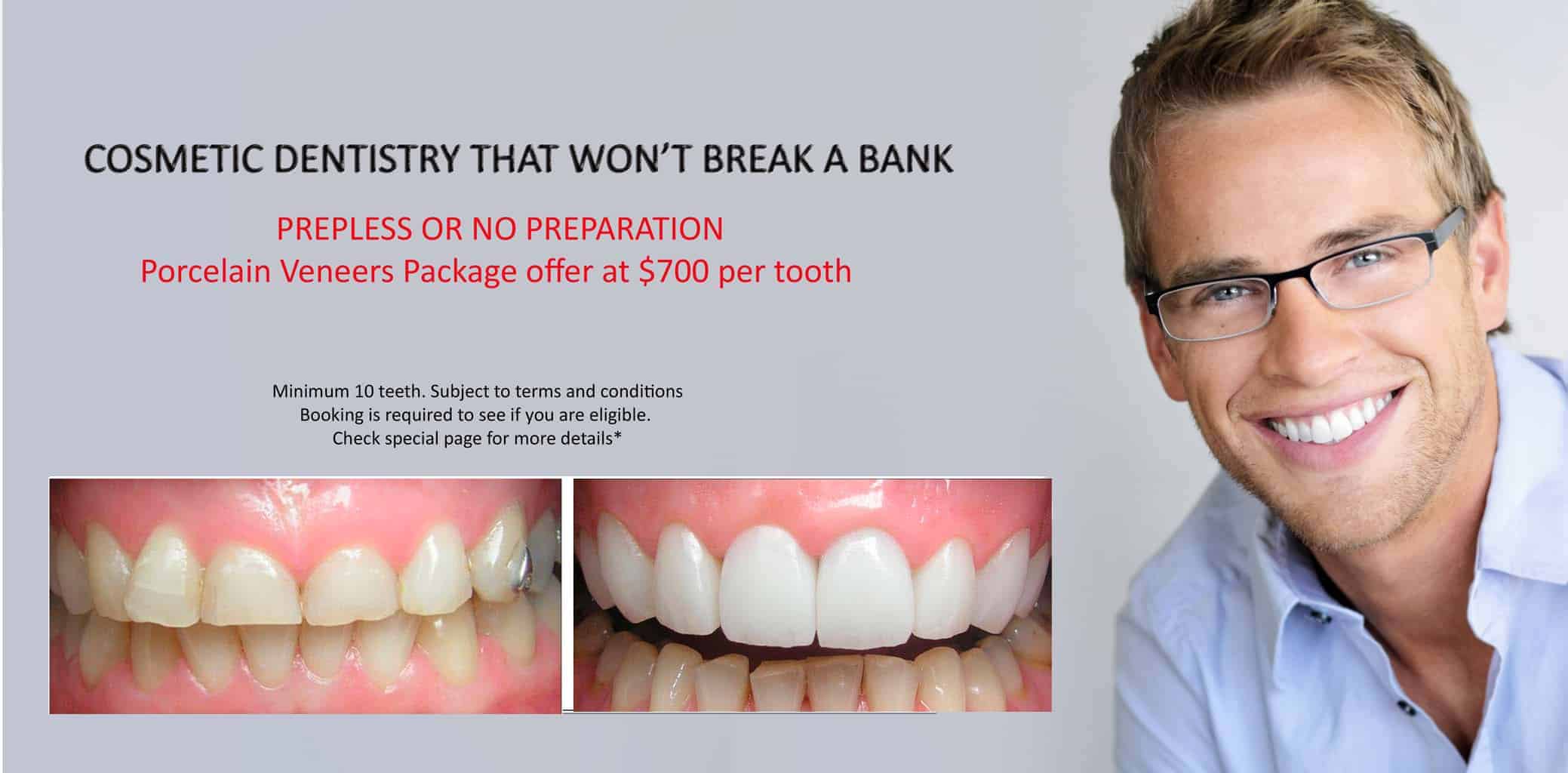
Dr Zenaidy Castro – top, leading, famous Cosmetic Dentist in Melbourne Victoria Australia. Famous Australian Photographer and Abstract artist
Disclaimer:


